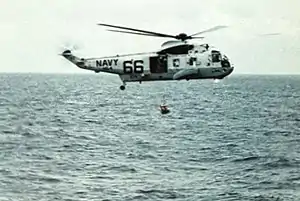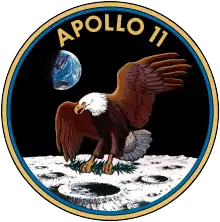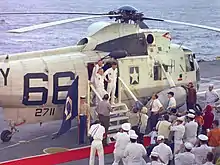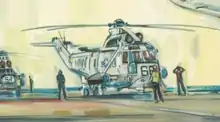Helicopter 66
Helicopter 66 is a United States Navy Sikorsky Sea King helicopter used during the late 1960s for the water recovery of astronauts during five missions of the Apollo program. It has been called "one of the most famous, or at least most iconic, helicopters in history", was the subject of a 1969 song by Manuela, and was made into a die-cast model by Dinky Toys. In addition to its work in support of NASA, Helicopter 66 also transported the Shah of Iran during his 1973 visit to the aircraft carrier USS Kitty Hawk.
| Helicopter 66 | |
|---|---|
 | |
| Helicopter 66 pictured in 1969 | |
| Other name(s) | "Old 66",[1] Helicopter 740 |
| Type | Helicopter |
| Manufacturer | Sikorsky Aircraft |
| Serial | BuNo 152711[1] |
| Owners and operators | U.S. Navy |
| In service | 1968–1975 |
| Last flight | June 4, 1975 |
| Total hours | 3,245.2 |
| Fate | Crashed and sank in the Pacific Ocean |
Helicopter 66 was delivered to the U.S. Navy in 1967 and formed part of the inventory of U.S. Navy Helicopter Anti-Submarine Squadron Four for the duration of its active life. Among its pilots during this period was Donald S. Jones, who would go on to command the United States Third Fleet. Later re-numbered Helicopter 740, the aircraft crashed in the Pacific Ocean in 1975 during a training exercise. At the time of its crash, it had logged more than 3,200 hours of service.
Design

Helicopter 66 was a Sikorsky Sea King SH-3D.[2] The SH-3D model Sea Kings were designed for anti-submarine warfare (ASW) and were typically configured to carry a crew of four and up to three passengers.[3] Powered by two General Electric T58-GE-10 turboshaft engines producing up to 1,400 horsepower (1,000 kW) each, SH-3Ds had a maximum airspeed of 120 knots (220 km/h; 140 mph) and a mission endurance averaging 4.5 hours.[3][4] They had a maximum allowable weight of 20,500 pounds (9,300 kg) with the ability to carry an external payload of up to 6,000 pounds (2,700 kg).[3]
During ASW missions, the Sea King SH-3D was typically armed with MK-46/44 torpedoes.[3]
History
Early history and Apollo missions
 |
| Part of a series on |
| Apollo 11 |
|---|
|
Helicopter 66 was delivered to the U.S. Navy on March 4, 1967, and, in 1968, was added to the inventory of U.S. Navy Helicopter Anti-Submarine Squadron Four (HS-4).[2] Its original tail number was NT-66/2711.[5]
Activated on June 30, 1952, Squadron Four—"the Black Knights"—was the first anti-submarine warfare helicopter squadron of the U.S. Navy to deploy aboard an aircraft carrier when, in 1953, it operated from USS Rendova. It began using the Sea King SH-3D in 1968, transitioning from the SH-3A model. That year, the squadron was assigned to Carrier Anti-Submarine Air Group 59 and deployed aboard USS Yorktown to the Sea of Japan in response to the capture of USS Pueblo by the Korean People's Navy. Later that year, Yorktown—and Squadron Four—was tasked to support the National Aeronautics and Space Administration (NASA) in the oceanic recovery of returning astronauts.[2][lower-alpha 1]

During the Apollo 8, Apollo 10, and Apollo 11 missions, Helicopter 66 was the primary recovery vehicle which hoisted returning astronauts from the spacecraft command modules.[2][8] As a result, it was featured prominently in television news coverage and still photography, achieving—in the words of space historian Dwayne A. Day—the status of "one of the most famous, or at least most iconic, helicopters in history".[2][9] Commander Donald S. Jones, who would later command the United States Third Fleet, piloted Helicopter 66 during its inaugural astronaut recovery mission following Apollo 8, and again during the Apollo 11 recovery of command module Columbia.[10]
Following the Apollo 11 mission, the Navy switched to a three-digit designation system and Helicopter 66 was retagged Helicopter 740.[2] Recognizing the fame Helicopter 66 had achieved, the Navy began the practice of repainting Helicopter 740 as Helicopter 66 for the later recovery missions in which it participated, Apollo 12 and Apollo 13, painting it back as Helicopter 740 at the conclusion of each mission.[2][11] During the period of its use for astronaut recovery, Helicopter 66 bore victory markings on its fuselage showing a space capsule silhouette, with one being added for each recovery in which it participated.[12] For the recovery of the Apollo 11 astronauts, the underside of the fuselage was emblazoned with the words "Hail, Columbia".[13][lower-alpha 2]
List of Helicopter 66 Apollo recovery flights
| Mission | Flight date | Base ship | Pilot | Reference |
|---|---|---|---|---|
| Apollo 8 | December 27, 1968 | USS Yorktown | Donald S. Jones | [2][16] |
| Apollo 10 | May 26, 1969 | USS Princeton | Chuck B. Smiley | [2] |
| Apollo 11 | July 24, 1969 | USS Hornet | Donald S. Jones | [2] |
| Apollo 12 | November 24, 1969 | USS Hornet | Warren E. Aut | [2] |
| Apollo 13 | April 17, 1970 | USS Iwo Jima | Chuck B. Smiley | [2] |
Later history and crash
From 1970 to 1972 Helicopter Squadron Four and Helicopter 66 were embarked aboard USS Ticonderoga CVS-14, and By 1973 Helicopter Squadron Four, and Helicopter 66 with it, were embarked aboard USS Kitty Hawk. That year, Helicopter 66 transported the Shah of Iran, Mohammad Reza Pahlavi, to Kitty Hawk for a shipboard visit while it transited the Indian Ocean.[17]
At 7:00 p.m. on June 4, 1975, Helicopter 66, renumbered as '740',[18] departed Naval Outlying Landing Field Imperial Beach near San Diego, California, en route to the U.S. Navy's Helo Offshore Training Area to conduct a regularly scheduled, three-hour nighttime anti-submarine training exercise.[2][19] During the operation, in which it was carrying a full complement of four crew, the helicopter crashed.[2][19] Though the crew was rescued by the U.S. Coast Guard, pilot Leo Rolek was critically injured and later died of the wounds he sustained in the crash.[2][19] The exact cause of the downing of Helicopter 66 is unknown; as of 2017 the U.S. Navy incident report remains largely classified.[20] The broken fuselage of the helicopter later sank in 800 fathoms (1,500 m) of water.[19] At the time of its crash, Helicopter 66 had flown 3,245.2 flight hours since being brought into service, and 183.6 hours since its last overhaul.[20]
The submerged helicopter remains the property of the U.S. Navy, and a 2004 effort by private interests to recover it for preservation was not realized.[2][20]
.jpg.webp)
Legacy

A painting of Helicopter 66 was commissioned in 1969 from artist Tom O'Hara as part of a NASA art initiative.[21] It was subsequently placed in the custody of the National Air and Space Museum.[21]
In September 1969 German singer Manuela released a single titled "Helicopter U.S. Navy 66" which features the sound of helicopter rotors.[22] The song was covered the next year by the Belgian pop singer Samantha, and was credited with helping launch her career.[23] In a 2007 interview, the popularity of "Helicopter U.S. Navy 66" as a closing song at dance clubs in 1970s Belgium was cited by the Belgian Schlager vocalist Laura Lynn as the inspiration for her hit "Goud".[24]
During the early 1970s Dinky Toys released a die-cast model of a Sea King helicopter in Helicopter 66 livery.[25] The model included a working winch which could lift a plastic space capsule toy.[25]
Replicas of Helicopter 66 are on display at the Evergreen Aviation & Space Museum in Oregon,[26] the USS Midway Museum[2] in San Diego, and the USS Hornet Museum in Alameda, California. The helicopter at the USS Hornet Museum is a retired Navy Sikorsky Sea King that was used in filming the 1995 motion picture Apollo 13.[27]
See also
Notes
- Early U.S. manned spaceflights used water landings during return to Earth due to the minimum additional technology needed to outfit the spacecraft.[7] The command capsule required only parachutes to slow its descent sufficiently for a survivable landing on a "soft" surface like water, instead of the retrorockets that would be required for a landing on a "hard" surface like land.[7]
- The name of the Apollo 11 command capsule was "Columbia" and President of the United States Richard Nixon, who was personally embarked aboard USS Hornet for the recovery, had ordered the Band of the COMNAVAIRPAC to perform "Columbia, the Gem of the Ocean" during the recovery.[14][15]
References
- "Sikorsky UH-3H Sea King". nambp.org. Naval Air Museum Barbers Point. Retrieved February 9, 2018.
- Day, Dwayne (June 25, 2007). "The last flight of Helo 66". The Space Review. Archived from the original on February 7, 2018. Retrieved November 3, 2017.
- "H-3 Sea King". fas.org. Federation of American Scientists. Archived from the original on February 7, 2018. Retrieved February 7, 2018.
- "S-61". Igor I. Sikorsky Historical Archives. Archived from the original on January 15, 2018.
- "Sikorsky UH-3H Sea King (S-61B) – USA – Navy". airliners.net. Leaf Group. Archived from the original on February 7, 2018. Retrieved February 7, 2018.
- Teitel, Amy (February 10, 2018). "Why Cosmonauts Have Never Splashed Down". Discover Magazine. Archived from the original on February 7, 2018. Retrieved May 12, 2018.
- Putnam, Milt. "Navy Photographer Tells the Story of Apollo 11 Recovery". Naval Historical Foundation. Archived from the original on February 7, 2018. Retrieved November 3, 2017.
- Blair, Don (2004). Splashdown!: NASA and the Navy. Turner Publishing Company. p. 43. ISBN 978-1-56311-985-9.
- Carmichael, Scott (2012). Moon Men Return: USS Hornet and the Recovery of the Apollo 11 Astronauts. Naval Institute Press. pp. 121–122. ISBN 978-1-61251-252-5.
- "From One to Another". Vertical Magazine. April 12, 2012. Archived from the original on February 7, 2018. Retrieved November 3, 2017.
- "Helicopter Unit Changes Command". Chula Vista Star-News. newspapers.com. September 26, 1971. p. 20. Retrieved February 7, 2018.(subscription required)
- Ron Nessen (July 24, 1969). NBC News (television). National Broadcasting Company.
The President's applauding as they play "Columbia, the Gem of the Ocean." Columbia, of course, is the module out there ... We understand that President Nixon requested the band play "Columbia, the Gem of the Ocean". Written on the bottom of the helicopter is another welcome aboard for the astronauts, it says "Hail, Columbia".
- Nixon, Richard (2013). RN: The Memoirs of Richard Nixon. Simon and Schuster. p. 172. ISBN 978-1-4767-3183-4.
- "Astronauts Aboard Carrier". St. Louis Post-Dispatch. July 24, 1969. p. 1. Retrieved September 27, 2017.(subscription required)
- "Helicopter 66 crash". Check-Six.com. Retrieved August 14, 2018.
- "Kitty Hawk II (CVA-63)". Naval History and Heritage Command. U.S. Navy. Archived from the original on February 7, 2018. Retrieved February 7, 2018.
- "The Final Flight". Check-Six.com.
- "Aircraft Accident Report" (PDF) (Original U.S. Navy accident report uploaded by The Space Review). United States Navy aircraft mishap board. pp. 1–4. Archived from the original on February 7, 2018. Retrieved February 7, 2018 – via The Space Review.
- Day, Dwayne (September 17, 2017). "It's time to recover Helo 66". The Space Review. Archived from the original on February 7, 2018. Retrieved November 3, 2017.
- "Recovery Helicopter #66". airandspace.si.edu. Smithsonian Institution. Retrieved November 3, 2017.
- "Manuela – Helicopter U.S. Navy 66 (song)". germancharts.com (in German). Bundesverband Musikindustrie. Retrieved February 8, 2018.
- "Hoe zou het zijn met Samantha?" (in Dutch). Radio 2. June 24, 2016. Retrieved February 11, 2018.
- "Home Muziek Radio & Televisie Musical & Theater Film Fotoalbums Kalender Wedstrijden "Goud" nieuwe album van Laura Lynn!". Front View Magazine (in Dutch). June 7, 2007. Retrieved February 11, 2018.
- Lomax, Frank (June 1971). "Dinky Toys News Space Recovery Special". Meccano Magazine. p. 274. Retrieved February 7, 2018.
- "Artifact Pick of the Week". evergreenmuseum.org. Evergreen Aviation & Space Museum. Archived from the original on February 7, 2018. Retrieved February 7, 2018.
- Day, Dwayne (July 9, 2007). "Helo 66 revisited". The Space Review. Archived from the original on February 7, 2018. Retrieved November 3, 2017.
External links
 Media related to Helicopter 66 at Wikimedia Commons
Media related to Helicopter 66 at Wikimedia Commons- Podcast interview featuring Doug Hill, former Maintenance Officer on Helicopter 66 and the Blue Angels